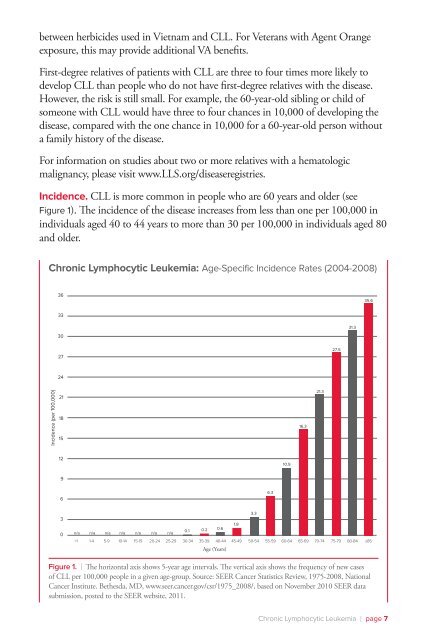Chronic Lymphocytic Leukemia - The Leukemia & Lymphoma Society
Chronic Lymphocytic Leukemia - The Leukemia & Lymphoma Society
Chronic Lymphocytic Leukemia - The Leukemia & Lymphoma Society
Create successful ePaper yourself
Turn your PDF publications into a flip-book with our unique Google optimized e-Paper software.
etween herbicides used in Vietnam and CLL. For Veterans with Agent Orange<br />
exposure, this may provide additional VA benefits.<br />
First-degree relatives of patients with CLL are three to four times more likely to<br />
develop CLL than people who do not have first-degree relatives with the disease.<br />
However, the risk is still small. For example, the 60-year-old sibling or child of<br />
someone with CLL would have three to four chances in 10,000 of developing the<br />
disease, compared with the one chance in 10,000 for a 60-year-old person without<br />
a family history of the disease.<br />
For information on studies about two or more relatives with a hematologic<br />
malignancy, please visit www.LLS.org/diseaseregistries.<br />
Incidence. CLL is more common in people who are 60 years and older (see<br />
Figure 1). <strong>The</strong> incidence of the disease increases from less than one per 100,000 in<br />
individuals aged 40 to 44 years to more than 30 per 100,000 in individuals aged 80<br />
and older.<br />
<strong>Chronic</strong> <strong>Lymphocytic</strong> <strong>Leukemia</strong>: Age-Specific Incidence Rates (2004-2008)<br />
Incidence (per 100,000)<br />
36<br />
33<br />
30<br />
27<br />
24<br />
21<br />
18<br />
15<br />
12<br />
9<br />
6<br />
3.3<br />
3<br />
1.8<br />
0 n/a n/a n/a n/a n/a n/a n/a<br />
0.1 0.2 0.6<br />

















